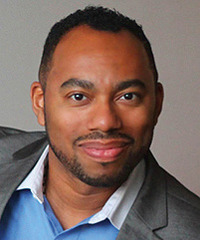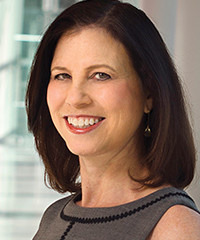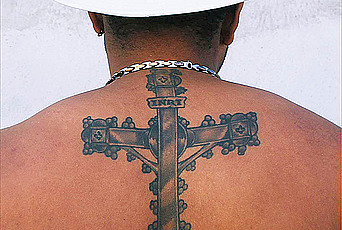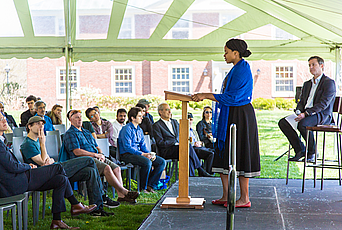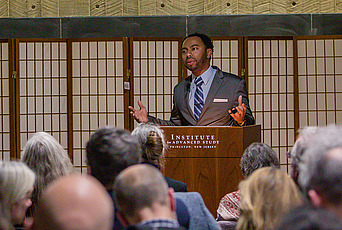Cord Whitaker, Friends of the Institute for Advanced Study Member in the School of Historical Studies at the Institute for Advanced Study, is researching nineteenth- and twentieth-century African American medievalism as it relates to the modern racial color-line. He is an associate professor of English at Wellesley College. His book, Black Metaphors: How Modern Racism Emerged from Medieval Race Thinking, traces racism from its roots in medieval history up to the present, including the violent 2017 white supremacist rally in Charlottesville. He spoke with Joanne Lipman, the Institute’s Distinguished Journalism Fellow, about the current racial unrest, its place in the timeline of historical racism, and where we go from here. This conversation was conducted on June 2, 2020. It has been edited for length and clarity.
Joanne Lipman: As we speak, there are protests around the country, sparked by the murder of George Floyd. Does this moment surprise you, or was it inevitable?
Cord Whitaker: This moment deeply disturbs me and makes me quite sad, quite angry, quite disappointed, but it does not surprise me in the least.
I’ve written significantly on the Charlottesville events of August 2017, which were quite similar in nature. We tend to think of them in a slightly different way, of course. That was a protest arranged by the far right, alt-right, and other white supremacist forces, and was counter-protested by anti-racist demonstrators. It broke into violence when the white supremacist organizations became aggressive. What we are experiencing now started out with anti-racist protestors protesting police brutality, and really protesting to draw attention to the right of black people, people of color, and ultimately all people, to live free of fear for their lives, and also to have equal opportunities of the economic, material, as well as emotional and spiritual sorts. It was very quickly met with counter-violence.
A lot of the media conversation has been about looting and violence, some of which is certainly coming from young disenfranchised people who are simply enraged, but a lot of it is also certainly coming from agent provocateurs—who are purposefully derailing the protests. Well, they haven’t successfully derailed the protests. They’re derailing the image of the protests. On one hand, there are people who are opportunists, and on the other, there are those who are honestly against the cause of the protests, people who harbor white supremacist viewpoints. It has been shocking to me how many images I’ve seen of looters who appear to identify as white, and appear to not have been involved in the protests earlier in the day, which can mean only two things: opportunism, or outright action against protest and against equal rights.
There are elements here that are different from previous protests, different from Charlottesville, different from the protests of 1967, and before that, the protests of the late 1910s, and so on, back through modern and into early modern and medieval history. But ultimately, what it comes down to is that some people are agitating for the right of people to live free of fear and with opportunity, and there is also a significant faction that stands against those goals.
JL: We’ve had activism for equal rights for at least the last century or century and a half. Why can’t we turn the tide?
CW: I can’t say that we haven’t turned the tide. Certainly, things still look quite bad. Certainly, there are still major problems. If, however, you look at the makeup of the anti-police brutality protests over the past several days, if you just take a sweep of the crowd, they do look far more diverse than they did previously.
Certainly, in the days of Dr. King, if you look at the video from Selma, you see some wonderful white allies front and center. But they didn’t permeate the crowd to quite the same degree as images of today’s protests show us. So the discourse has changed. Quite a lot of people who have not been involved in anti-racist protests before, people who have even felt uncomfortable speaking about race, who thought it wasn’t their place, do seem to feel the call to speak out now. To speak out in favor of racial equality and against police and other racist forms of brutality. This is feeding the energy of the peaceful protesting that we’ve seen.
We’re in a moment in American history where, because of the events of the past several years, because of things like Charlottesville, because of the current White House administration, people are able to see more clearly than ever before that the forces of racism are endemic to the U.S. power and economic structures. I think that we have turned a bit of a tide.
JL: Will the protests lead to lasting change?
CW: As to what will happen next, there are a couple of things in play. One of the things that happened in the past couple of days was that the U.S. president appeared in front of a church holding a Bible upside down. This may have been in error—he was hastily handed the Bible—so him holding it upside down may have been in error.
But there’s a pretty good tradition of iconography of Nazis, white supremacists, etcetera, distorting Christian images. An upside- down Bible can also function as a sort of dog whistle, a signal to white supremacist forces that may not have fully organized yet. A lot of them became a bit scattershot after Charlottesville. This could be a call for them to organize further. We may see more organized and obvious counter-protesting by white supremacist groups in the next few days or weeks.
JL: Is the upside-down Bible a familiar insignia in this world?
CW: As far as the specifics of an upside-down Bible, not specifically. Certainly, distorted or upside-down crosses, yes. Indeed, even the swastika or hooked cross has been considered by some a distorted Christian cross, alongside its more ancient spiritual and cultural uses.
All of this is quite alarming. But I do think that the energy that we’re seeing in the protests is something we can be quite optimistic about.
JL: Yes, you referenced the increase in white faces during the current protests. What role can white allies play?
CW: Every community is different. If your organization has a lot of members who are persons of color, then it should ask those members for some ideas about what might make sense for your particular town, for your particular milieu. At the same time, one should recognize that people of color, black people, especially those who’ve been busy in their careers and in their extra-professional lives agitating for racial justice, are very tired.
This is something I have personally experienced. From the moment I saw video of George Floyd being assaulted and then murdered, I was overcome with exhaustion, because I’ve been outraged so many times before. I have found myself at my desk reading medieval documentary evidence that led to our modern racism, holding my head in my hands, for the past 20 plus years, and have written on it at great length. For some reason when I saw that video, all of that came rushing back in a way that brought to me a feeling of utter exhaustion.
I’ve talked now to several other black scholars who feel the same way. I find it interesting that this occurs at the exact same moment where many others are feeling much more energized, and feeling an anger that they’ve never felt before. So there’s something in a way that’s exciting and makes me optimistic about this, in that after the work that so many of us have done, in this moment, we may be able to pass the baton a little bit. We can pass the baton to those who are new to the fight and are ready to agitate and really put all of their heart and soul into it in a way we have not seen in the past. I cannot predict exactly where it will go. I cannot say what we can achieve in the name of racial justice in the next six months or a year or two years. But I think it will be noticeable. And I think we’ll enter into a slightly new world after that, where we have to recalibrate what agitating for even further justice will mean. So things are changing. Also, whenever you have significant political and social change afoot, that’s also when those who would arrest that change become the most desperate, and even the most violent. So I think everyone needs to be prepared for that, mentally and emotionally.
JL: Your book, Black Metaphors: How Modern Racism Emerged from Medieval Race Thinking, seems very prescient right now. You trace racism from its Middle Ages roots to the present, with the rise of white supremacy and the Black Lives Matter movement. How are those elements connected?
CW: My book very much begins with the Black Lives Matter movement. It begins with the idea of blackness and whiteness, and the idea that we think of black and white as opposites.
I undertake the rhetoric of something like Black Lives Matter and the counter-rhetoric of All Lives Matter in the context of understanding the history of the relationship between black and white, as concepts, as abstract things that then get transplanted onto human beings. When you look at classical unto medieval color theory, black and white are actually not opposites. They’re the two primary colors, and everything else is made out of them.
So the book takes off from that point. Everything in between in the book is about medieval literature and history, religious conflict, and how the range of meanings of blackness was significantly greater in the Middle Ages. It could equal sin and depravity, but it could also be a symbol of extreme holiness. From the mid-thirteenth century on, the patron saint of the Holy Roman Empire was depicted—especially in Germany, near the seat of the Holy Roman Empire—as a black man, St. Maurice, whose name of course has resonances with the word Moor, or Moorish.
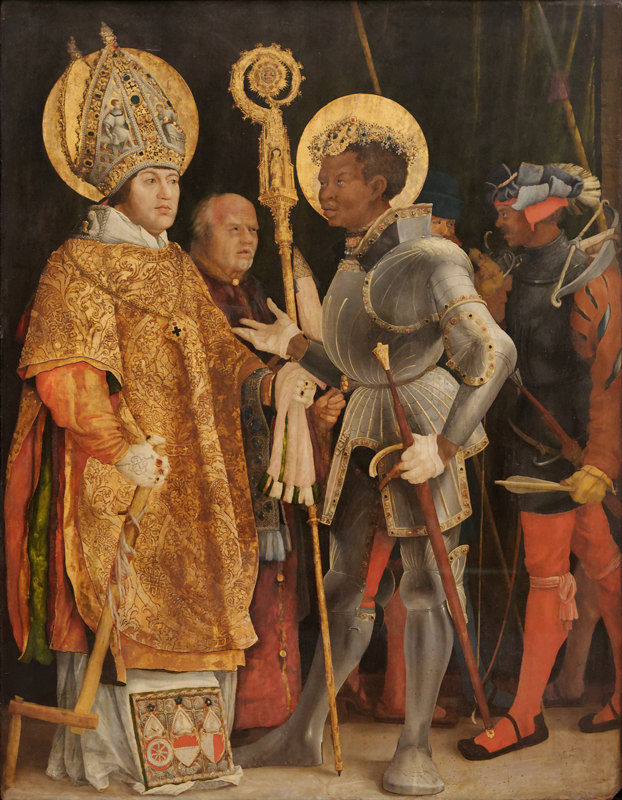
A lot of us noticed some of the white supremacists demonstrating at Charlottesville were using insignia that are regularly associated historically and in medieval art with St. Maurice. This is the sort of thing that sometimes gets alt-right members and white supremacists who use medieval images into trouble.
JL: When were those medieval symbols first appropriated by white supremacists? I believe the KKK used those symbols in the nineteenth century.
CW: Right. The whole names of several Ku Klux Klan chapters include “White Knights of the Ku Klux Klan.” So the medieval idea of knighthood, the medieval idea of chivalry, is baked right into that organization’s very being.
JL: How does medievalism play into the current moment?
CW: The idea of knighthood is active in what we’re seeing right now. In Black Metaphors, I deal with the fact that Mussolini as well as today’s alt-right leaders, including Richard Spencer, were influenced by an Italian philosopher contemporary with Mussolini named Julius Evola. Evola fancied himself a medievalist as well. And he argued essentially that the Templars and some other figures throughout history have presented a kind of knighthood, a kind of chivalry, that supersedes Christianity. It supersedes the Church. It supersedes anything devotional. And that this knighthood is indeed traceable back to Germanic warrior cultures, and that it also has relationship to Indo-Aryan history as well.
In so doing, he argues for a kind of knighthood that comes with whiteness, and white maleness in particular. It’s a sort of hereditary knighthood. This influenced Mussolini, whose interest was in the development of the Italian as a “new man.” He wanted to renew Italian prominence. Ultimately, he did this by arguing for the Italians sharing in a Nordic heritage, which is of course a pretty strange claim to make, but it worked at the time, and it certainly worked for Hitler and the Nazis. The same Evola who makes these arguments is also read by the likes of Richard Spencer and Steve Bannon. Richard Spencer called him “one of the most interesting men of the twentieth century.” So this is a place where the idea that a white man, however disenfranchised he may be economically, however he may be struggling, shouldn’t have to struggle, because he is internally and through no doing of his own a knight imbued with superlative spiritual power.
JL: Which leads to the concept of entitlement.
CW: Precisely. It also can lead to having one’s ego quite stroked by being a member of a neo-fascist or alt-right or neo-Nazi group. It’s one of the ways in which they do recruitment. It’s also present right now, in counteractions against protests for racial justice. A WHYY reporter documented a group of mostly young white men in Fishtown, which is a rapidly gentrifying neighborhood in the northeast of Philadelphia, defending their neighborhood as they paraded around the neighborhood with bats, as they yelled epithets, including the N-word, at peaceful protestors. By the end of the affair, they assaulted the WHYY reporter, who then had to go to a hospital. While their behavior appears on its surface thuggish or unthinking or out of control, they had indeed formed a roving band, not unlike knights errant. And this roving band was something that I’m certain that Julius Evola would look at and say it was exactly the right thing to do. They had become their neighborhood’s knights, and he would have said that what they were doing was imbued with superlative worth.
JL: Yet when we think about the medieval world in popular culture, we think about the fairy-tale aspects. The Renaissance fairs with the knights and the jousting and the symbols. We think about medieval dinners.
Does the appropriation of medieval history by the white supremacist movement impact these pop culture events? Have they also been coopted, in a way?
CW: It works a little bit more the other way around. It has to do with white supremacist recruitment tactics, which I regularly compare to ISIS or ISIL recruitment tactics. A lot of your young people, mostly young men, who are interested in things medieval, who play the right video games, who want to go to Medieval Times, that sort of thing, are also often considered nerds and/or are ostracized. This has been central to the development of a group of people who a lot of folks call incels—involuntary celibates -—who come together in places like certain Reddit rooms. And it can involve a lot of misogyny, because that misogyny is a reaction to feeling rejected, being outcast, all of that intersecting with a kind of adolescent angst that everyone experiences at some point anyway. If a recruiter catches these young men at the right time in their lives on 4chan or Reddit or somewhere else, it can be really easy to turn that interest in chivalry and the kind of power that can come with chivalry, and that idea that you are naturally a knight—it can be very easy to use that to draw somebody in and then introduce them to the rest of your ideology, and then they can gain a sense of belonging and importance from it. So rather than white supremacists’ deployment of the Middle Ages affecting our pop culture medievalism, rather, our pop culture medievalism becomes a tool for recruiting into the white supremacist movement.
JL: What were you working on at IAS as we went into quarantine, and has that shifted in any way because of the events of the day?
CW: Everything has changed and shifted because of the events of the day. I am still working in the realm of medievalism’s comportment toward white supremacist ideology, but I’m doing it from a very different angle now.
At IAS I’ve been looking at black thinkers and intellectuals and writers of the early twentieth century, who were writing in the period before civil rights, but who were also writing in the wake of the nineteenth century’s absolute fascination with the Middle Ages. I’m working on some very well-known African American thinkers, such as W. E. B. DuBois, and his use of the Middle Ages, as well as some lesser known figures, such as Jessie Redmon Fauset, who I think should be much better known, and indeed was much better known during the Harlem Renaissance.
Before the events of the past week, I thought mainly about their medievalist interventions in literature, in visual art, and in an intellectual milieu.
JL: And now?
CW: The events of the past week make me wonder to what extent this project should take up protest and insurgency, and to what extent their literature and their art intersected with direct action. Black Metaphors did deal with some of the politics of color and rhetoric regarding direct action. The next book wasn’t going there … but maybe now it is.

